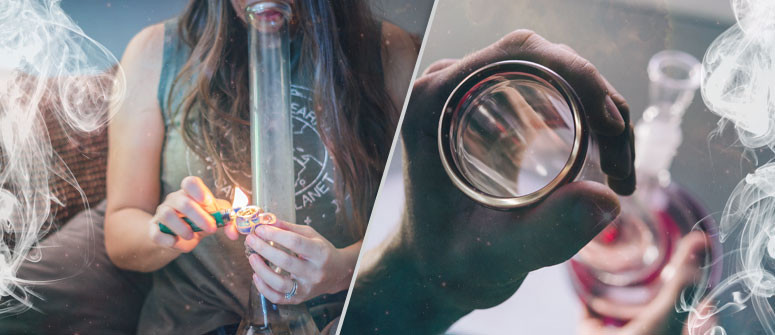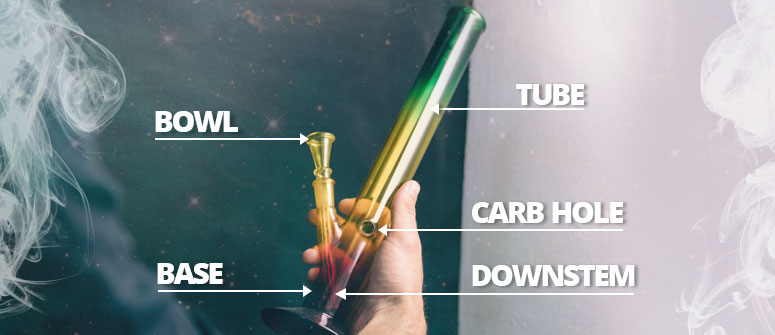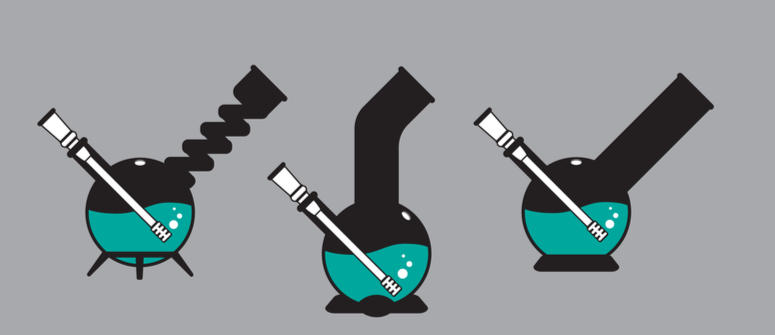Bongs: what they are and how to use them

Since ancient times, bongs have been a popular way to smoke weed. Made from all sorts of materials and in different designs, we give you the full rundown on bongs, including their advantages and disadvantages. Our step-by-step guide will help you select the bong most suited to your needs, and show you how to use it!
Contents:
Anyone who has been around cannabis for a while has experimented with ways to enjoy the plant. There are many different methods, actually—even when it comes to smoking. One of the most popular ways to smoke cannabis is with a bong.
Bongs are really just water pipes. They are frequently used by cannabis smokers to enhance the experience and cool down the inhaled smoke. Bongs come in all sizes, shapes, and materials. You’ll find models made from wood, glass, acrylic, clay, bamboo, and ceramics. No matter what they look like, or what they are made of, they all work in generally the same way. Every other variation is up to the imagination of the manufacturer/artisan.
HISTORY OF THE BONG
The use of ancient bongs can be traced back as far as 2,400 years ago. Recent Russian excavations show fancy bongs made from gold by the Iranian-Eurasian Scythe tribe. Other, more primitive bongs were discovered previously in parts of Africa and Central Asia. These were often made from ceramics or animal horns, and date between 1100 and 1400 AD.
The word “bong” comes from the Thai word “baung”, the name for bamboo tube bongs that were very popular in Central Asia. As bongs developed into the modern versions of today, the name stuck.
Historical reports claim that Chinese dynasties introduced the use of water in bongs. True or not, the royal status of water pipe bongs during this time is undeniable. Various emperors were buried with their precious pieces.
ANATOMY OF THE BONG

• Bowl: This is the bulbous attachment where dried flower is loaded and then combusted. Sometimes, this part is removable.
• Carb hole: Short for carburetor, the carb is a small hole that allows the user to clear smoke from the bong chamber. Fancier types have the carb built-in, while other bongs involve removing the bowl to act as a carb.
• Downstem: The small tube that allows smoke to travel from the bowl to the base is called the downstem. This then allows the smoke to be percolated through the water.
• Base: At the bottom of the bong, you'll find the base. It can take many shapes. Usually, it’s shaped like a bubble or beaker.
• Tube: The tube ends in the mouthpiece. It’s the chamber that fills with smoke after it has been filtered through water. Modern bongs have all kinds of twists on the same, including splash guards and so-called “ice pinches”. The latter are cavities in the tube where ice can be applied to further cool the smoke as it is inhaled.
BONG MATERIALS
As mentioned above, bongs can be made from many materials. While there is technically no “best” material, each has its pros and cons, and some will be more suited to certain situations.
GLASS BONGS
Beyond a doubt, glass bongs are number one. This material doesn’t affect the flavour of your cannabis at all; a glass bong ensures a clean, pure taste.
From a practical point of view, the transparency of glass also has advantages. Resin build-up can be spotted right away, which will be easy to clean out. On the downside, glass bongs are the most expensive. They are also difficult to travel with, as they can be heavy and more prone to breaking. That said, glass bongs made from borosilicate can withstand a good bump or two.
ACRYLIC BONGS
Acrylic bongs are a popular choice too, but for different reasons than glass. This material makes them very durable, so you will seldom have to worry about one breaking when you pass it around in company. Or when you travel.
Even if it does break or shatter one day, they are the cheapest type of bongs. However, there is one disadvantage. Acrylic tends to affect the flavour of your bud a little bit.
CERAMIC BONGS
For those who like their bong to double as an art object, a ceramic bong is it! They come in all sorts of unique shapes and colours, complementing your interior in a beautiful way. Usually, they are quite heavy and bulky: not handy for passing around. This makes them more suited for special occasions rather than daily smoking.
Due to their fragility, travelling with a ceramic bong is a challenge. They are typically a little more expensive than acrylic bongs, but still much cheaper than glass bongs.
BAMBOO & WOOD BONGS
Go back to basics with a bong made from bamboo or wood. These natural materials come cheap and are extremely durable. If you take proper care of them, they will last forever. So get a simple bamboo tube version or a more intricate one to paint and decorate. The only inconvenience is that they can be hard to clean.
METAL BONGS
Not as popular as glass or acrylic, metal bongs are also an option. This material is very sturdy and durable, and quite inexpensive. Disadvantages are that you can’t tell when it’s time to clean it, and the taste of your cannabis can be affected.
OTHER OPTIONS
There are many other everyday materials you can use to build your own bong. These make good quick solutions when you don’t have your piece with you.
You can get really creative here and use things such as fruits, vegetables, water bottles, or Lego blocks. And, of course, you can make a gravity bong using a 2l bottle or a bucket for the ultimate DIY bong.
BONG DESIGNS

Besides different materials, bongs feature many different designs and shapes. Some of the most sought-after include:
CARBURETOR BONGS
Any bong with a carb hole qualifies as a carburetor bong. It’s usually located somewhere in the middle so you can easily hold your finger over it. Fresh air enters the pipe when you release, which causes a much stronger hit when drawn.
STRAIGHT-TUBE BONGS
The name says it all; this bong is basically just a straight tube with a bowl and stem. Simple and straightforward.
ROUND-BASE BONGS
A more stable variant to straight-tube bongs are round-based bongs or bubble bongs. The sphere-shaped water chamber offers a more solid foundation.
BEAKER-SHAPED BONGS
Very similar to the round-base bong, except that the chamber is in the shape of a beaker. The larger, flat base makes them even more stable.
PERCOLATOR BONGS
Also known as a bubbler bong. The base can take on any shape, and percolators are added to further filter the smoke. When you take your hits, the smoke will bubble as it goes through the water. This will make for a smoother hit, although these bongs are harder to clean.
MULTI-CHAMBER BONGS
Also referred to as the recycler bong. This bong has multiple chambers, connected by another chamber or tube. Water is contained in both chambers, filtering the smoke twice. The extra cleaning required is worth the far smoother hit it produces.
HOW TO USE A BONG
Now, let’s take you through our step-by-step guide on how to operate a bong.
• Step 1: Pour water into the tube. Make sure it’s enough water to cover the bottom third of the downstem, but not so much that you end up sucking in bong water.
• Step 2: Grind your cannabis to a medium-fine grind and pack the bowl, leaving some room for air to pass through.
• Step 3: Place your lips around the mouthpiece and light the bowl. Simultaneously, cover the carb hole if there is one to ensure all the smoke will flow into your mouth.
• Step 4: Now, take small **hits. There's no need to hold the smoke in your lungs; exhale as normal. Enjoy!
There are many things you can use to make your bong hits more pleasant. Add ice or water alternatives such as tea or fruit juice for variation. Also, make sure to maintain your bong by keeping it clean for an enhanced experience. Read all about how to clean your bong here.
ADVANTAGES OF USING A BONG
• Smoke is filtered through the water, producing a smoother, cooler draw
• Each inhalation is easier on the throat and lungs
• The aroma and flavour of your cannabis can be optimally enjoyed
• Requires less preparation than rolling a joint
• Huge hits!
• Fancy extras like ice-catchers and percs.
DISADVANTAGES OF USING A BONG
• Less straightforward than smoking a joint, with more components to pay attention to
• Can be quite costly, depending on which bong you get
• Requires maintenance and cleaning, with some bongs being more difficult to clean than others
WHICH BONG IS RIGHT FOR YOU?
Now that you have some information about the many different types of bongs available, compare each according to your personal needs and desires. Conduct some more research on the types that interest you, delving deeper into their pros and cons. Consider how often you will use your bong, and where. Another important factor is, of course, your budget. All these variables will help you decide which bong is right for you personally.
.jpg)
.jpg)

.jpg)
